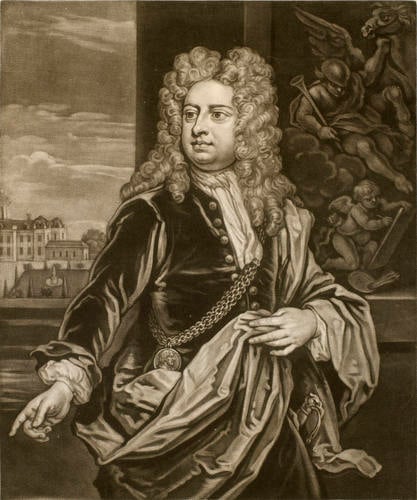Sir Godfrey Kneller 1735
Mezzotint | 36.4 x 26.6 cm (sheet of paper) | RCIN 657636
-
A mezzotint after a self-portrait of Sir Godfrey Kneller; three-quarter length, standing with his head turned three-quarters to the left. He gestures with his right hand and clasps his mantle in his left hand. Inscribed below: Se Ipse Pinx.t / I. Faber fecit 1735 / S.r Godfrey Kneller Bar.t & Kn.t of ye Roman Empire / Principal Painter to K. Charles 2.d James 2.d William 3.d Q. Ann & King George 1st.
This is the third of three prints which show how Kneller's public image evolved over the course of his career. Published after Kneller's death, it reproduces a self-portrait (National Portrait Gallery, London) that is a version with a different background of that sent by Kneller in 1706 to Cosimo III de' Medici, Grand Duke of Tuscany, for the Vasari Corridor. Kneller wears a gold chain with a portrait medallion of William III given to him by the king in 1699; in the background is a view of his country estate at Whitton in Middlesex. At upper right is an allegorical scene with Mercury, holding the trumpet of Fame in one hand and the reins of Pegasus in the other, looking down at a winged putto in the act of painting. It is surprising that Kneller did not commission Smith to reproduce the portrait: this is the earliest print to be made after the painting, produced 12 years after Kneller's death, to accompany Faber's series of mezzotints after Kneller's 'Kit-Cat Club' portraits. By then Kneller's reputation had outgrown the facts: the inscription below erroneously states that – among other honours – he was also Principal Painter to Charles II and James II. See also RCIN 657632, 657626.
Born in Germany, Godfrey Kneller trained in Amsterdam and travelled in Italy before settling in London in 1676. After the deaths of Peter Lely in 1680 and William Wissing in 1687, he established himself as the dominant portrait painter in England for the next 30 years: he was made Principal Painter to William III in 1689, knighted and made a Gentleman of the Privy Chamber in 1692, awarded an honorary doctorate by Oxford in 1695, made a knight of the Holy Roman Empire in 1700, confirmed as Principal Painter to Queen Anne in 1702 and to George I in 1714, and finally created a Baronet in 1715, a rank unsurpassed by an artist in Britain until Frederic Leighton was created Baron Leighton of Stretton almost two centuries later.
Kneller was hugely productive (Stewart 1983 catalogued 875 paintings) and assiduously promoted himself through self-portraiture and the publication of prints after his paintings. He formed close working relationships with Isaac Beckett, who made mezzotints of 28 of his works, and with Beckett's pupil and successor John Smith, who reproduced 113 of his portraits, publishing the majority himself.
Text adapted from Portrait of the Artist, London, 2016Provenance
Probably acquired by George III
-
Creator(s)
(mezzotinter) -
Medium and techniques
Mezzotint
Measurements
36.4 x 26.6 cm (sheet of paper)
35.3 x 25.5 cm (platemark)
Category
Object type(s)









